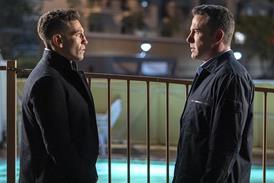The ’Loving Vincent’ filmmakers return with a vivid oil painted animation about life in 19th-century rural Poland.

Dirs/scr: DK Welchman, Hugh Welchman. Poland/Serbia/Lithuania. 2023. 114mins
Five years after earning an Oscar nomination for their film Loving Vincent, which revolved around the work of Vincent van Gogh, directors DK Welchman and Hugh Welchman deliver another truly impressive animated work. Based on a novel about life in an early 19th century Polish village of peasant farmers, The Peasants again melds oil paintings (some 40,000 of them) over live-action footage of actors to become a dynamic, immersive drama that brings the pleasures and pains of the past to ravishing life.
A dynamic, immersive drama that brings the pleasures and pains of the past to ravishing life
While the Welchmans could easily have dedicated this follow-up to another well-known painter, they have instead taken the bold decision to adapt the 1,000-page novel by Polish author Wladyslaw Reymont, written between 1904 and 1909. (Reymont went on to win the Nobel Prize for Literature in 1924.) While a lack of wider recognition may prove a commercial challenge, the success of Loving Vincent and this film’s incredible visuals, not to mention positive word of mouth following its Toronto premiere and subsequent London Film Festival berth, may well prove a potent recipe for wider play.
While the source may be obscure to those outside of Poland, its central story — of the condemnation and punishment metered out by a patriarchal society — is a universal tale as old as time. Condensing the originally four-part novel, The Peasants focuses on the character of Jagna (Kamila Urzedowska), a beautiful young woman living in a small-minded 19th-century Polish village. Strong-willed and free-spirited, she is unwilling to settle down; even though she has caught the eye of every male for miles around.
Taking inspiration from the Young Poland creative movement to which novelist Reymont belonged, The Peasants draws on artists from the same period; over 30, including Michal Gorstkin-Wywiorski, Ferdynand Ruszczyc and, particularly, realist Jozef Chelmonski. Again working with Piotr Dominak, head of painting on Loving Vincent, the filmmakers have created an astonishing palette which ranges from almost photographic realism to brush-stroke expressionism, vivid colours to pencil sketch monochromes, depending on the emotion of the scene and the time of year; the action cycles through the seasons, from the depths of winter to the drought-stricken heights of summer.
Yet this is not a static piece to be observed and admired but a fast-paced tale of love, lust and revenge, thanks to fluid editing from DK Welchman, Patrycja Pirog and Miki Wecel and performances which hold their own against the astonishing animation. Jagna’s independence puts her increasingly at odds with the rest of the village; jealous women gossip, call her a whore, while the men try to bed her. Forced to marry elderly local ‘first farmer’ Boryna (Miroslaw Baka), Jagna’s only happiness comes in the paper cut artworks she creates (birds in flight being a regular motif there and throughout the film) and the passionate affair she is having with Boryna’s married son Antek (Robert Gulaczyk), who is locked in an explosive disagreement with his father about land ownership.
Jagna and Antek’s first tryst is an intense, erotic moment, the camera moving with them, the chemistry crackling from the screen. And this almost-hypnotic camerawork is deployed to great effect elsewhere, too; not least at Jagna and Boryna’s wedding, where dancers whirl to increasingly frantic music. (Polish rapper Lucasz ‘LUC’ Rostkowski’s reworking of folk songs is an expertly-used highlight of the film.) In this extended sequence, revelrous energy soon turns into something more dangerous and dark, laying the groundwork for the devastating jealousies and betrayals that follow – with Jagna bearing the brunt of the punishment for so-called transgressions.
Jagna’s journey as a woman ousted for her otherness, for her unwillingness to blindly tow the patriarchal line, is one seen myriad times on screen, in everything from Mildred Pierce and The Handmaid’s Tale to The Scarlet Letter (with whom this film shares its repeating red motif — there a letter, here Jagna’s defiantly scarlet dress and hair tie). It is often difficult to watch, Jagna being sexually assaulted more than once, but these aspects are respectfully and sensitively handled.
One of the film’s most powerful moments sees the village women sing a melancholy folk song to Jagna; reminiscent of a similar scene of collective female grief in Ari Aster’s Midsommer (as is Jagna’s colourful floral headdress), it is a palpable moment of sisterhood, but also resignation. These women understand that Jagna’s fate, this total loss of autonomy, is borne by them all.
Production companies: Breakthru Films
International sales: New Europe Film Sales jan@neweuropefilmsales.com
Producers: Sean Bobbitt, Hugh Welchman
Screenplay: DK Welchman, Hugh Welchman.
Cinematography: Radoslaw Ladczuk, Kamil Polak, Szymon Kuriata
Production design: Elwira Pluta
Editing: DK Welchman, Patrycja Pirog, Miki Wecel
Music: Lucasz ‘LUC’ Rostkowski’
Main cast: Kamila Urzedowska, Miroslaw Baka, Robert Gulaczyk, Sonią Mietielica, Ewa Kasprzyk







![The Brightest SunScreen[Courtesy HKIFF]](https://d1nslcd7m2225b.cloudfront.net/Pictures/274x183/3/5/0/1448350_thebrightestsunscreencourtesyhkiff_312678.jpg)














![The Brightest SunScreen[Courtesy HKIFF]](https://d1nslcd7m2225b.cloudfront.net/Pictures/100x67/3/5/0/1448350_thebrightestsunscreencourtesyhkiff_312678.jpg)

